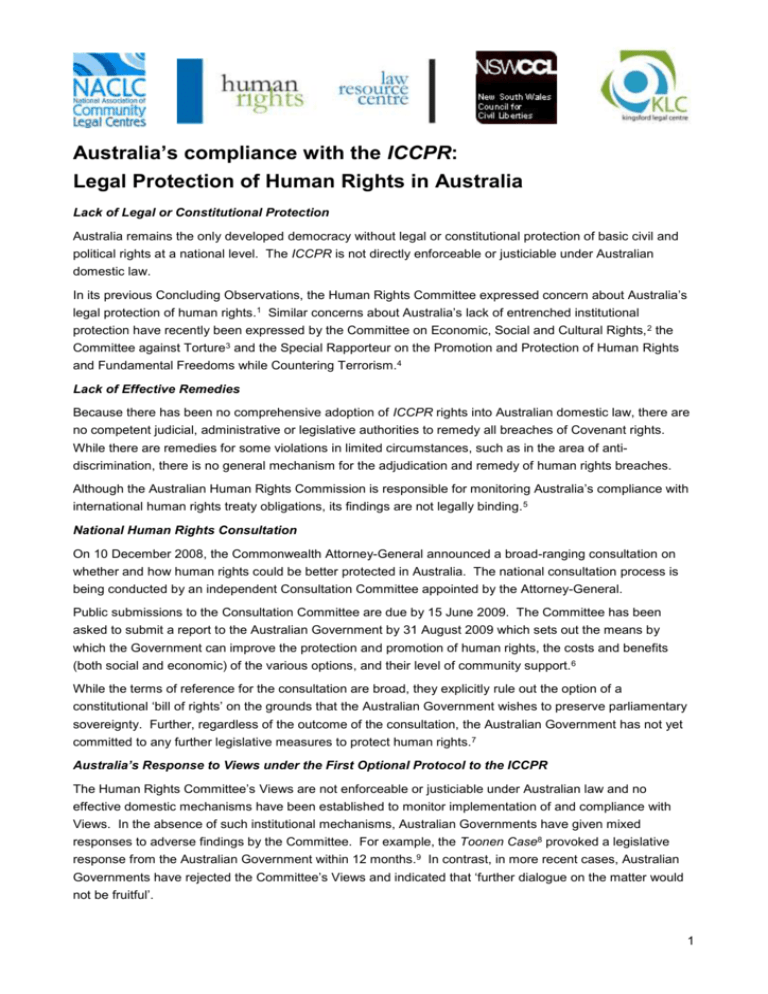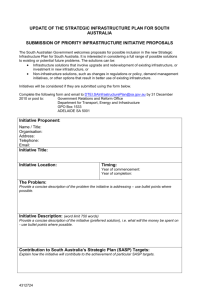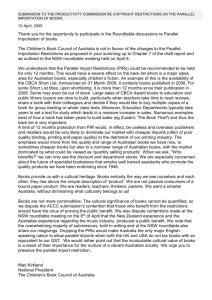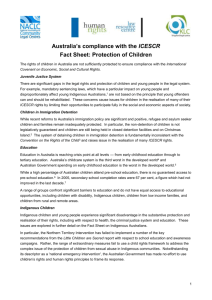
Australia’s compliance with the ICCPR:
Legal Protection of Human Rights in Australia
Lack of Legal or Constitutional Protection
Australia remains the only developed democracy without legal or constitutional protection of basic civil and
political rights at a national level. The ICCPR is not directly enforceable or justiciable under Australian
domestic law.
In its previous Concluding Observations, the Human Rights Committee expressed concern about Australia’s
legal protection of human rights.1 Similar concerns about Australia’s lack of entrenched institutional
protection have recently been expressed by the Committee on Economic, Social and Cultural Rights, 2 the
Committee against Torture3 and the Special Rapporteur on the Promotion and Protection of Human Rights
and Fundamental Freedoms while Countering Terrorism.4
Lack of Effective Remedies
Because there has been no comprehensive adoption of ICCPR rights into Australian domestic law, there are
no competent judicial, administrative or legislative authorities to remedy all breaches of Covenant rights.
While there are remedies for some violations in limited circumstances, such as in the area of antidiscrimination, there is no general mechanism for the adjudication and remedy of human rights breaches.
Although the Australian Human Rights Commission is responsible for monitoring Australia’s compliance with
international human rights treaty obligations, its findings are not legally binding. 5
National Human Rights Consultation
On 10 December 2008, the Commonwealth Attorney-General announced a broad-ranging consultation on
whether and how human rights could be better protected in Australia. The national consultation process is
being conducted by an independent Consultation Committee appointed by the Attorney-General.
Public submissions to the Consultation Committee are due by 15 June 2009. The Committee has been
asked to submit a report to the Australian Government by 31 August 2009 which sets out the means by
which the Government can improve the protection and promotion of human rights, the costs and benefits
(both social and economic) of the various options, and their level of community support. 6
While the terms of reference for the consultation are broad, they explicitly rule out the option of a
constitutional ‘bill of rights’ on the grounds that the Australian Government wishes to preserve parliamentary
sovereignty. Further, regardless of the outcome of the consultation, the Australian Government has not yet
committed to any further legislative measures to protect human rights.7
Australia’s Response to Views under the First Optional Protocol to the ICCPR
The Human Rights Committee’s Views are not enforceable or justiciable under Australian law and no
effective domestic mechanisms have been established to monitor implementation of and compliance with
Views. In the absence of such institutional mechanisms, Australian Governments have given mixed
responses to adverse findings by the Committee. For example, the Toonen Case8 provoked a legislative
response from the Australian Government within 12 months.9 In contrast, in more recent cases, Australian
Governments have rejected the Committee’s Views and indicated that ‘further dialogue on the matter would
not be fruitful’.
1
Australia and the Second Optional Protocol to the ICCPR
While the death penalty is not currently available in any Australian state or territory or for federal crimes, the
failure of the Australian Government to incorporate the Second Optional Protocol into domestic law means
that the reintroduction of capital punishment in Australia under state laws remains a possibility.
Australia’s Reservations to the ICCPR
The current Australian Government continues to maintain the reservations that Australia has previously
made in relation to the ICCPR, including in relation to Articles 10(2)(a) and (b), 10(3) (second sentence),
14(6) and 20.
TABLE OF CROSS-REFERENCES
Issue
Relevant Articles
References to Issue in NGO Submissions
of ICCPR
Lack of legal or constitutional protection
2
FREDA Submission Parts B.1 and 2
FREDA Addendum Parts B.1 and B.2
NSW CCL Submission Part 3.2
Lack of effective remedies
2(2)
FREDA Submission Parts B.1 and B.2
NSW CCL Submission Part 3.3
National Human Rights Consultation
2
First Optional Protocol
FREDA Submission Part B.1
FREDA Submission Part B.3
NSW CCL Submission Part 13
Second Optional Protocol
FREDA Submission Part B.3
NSW CCL Submission Part 14
Reservations
FREDA Submission Part B.5
Endnotes
1
Human Rights Committee, Concluding Observations of the Human Rights Committee: Australia, UN GAOR, 55th sess,
1967th mtg, [514], UN Doc A/55/40 (2000).
2
Committee on Economic, Social and Cultural Rights, Concluding Observations of the Committee on Economic, Social
and Cultural Rights: Australia, [14], [36], UN Doc E/C.12/1/Add.50 (2000).
3
Committee against Torture, Concluding Observations of the Committee against Torture: Australia, [9]–[10], UN Doc
CAT/C/AUS/CO/1 (2008).
4
Martin Scheinin, Report of the Special Rapporteur on the Promotion and Protection of Human Rights and Fundamental
Freedoms while Countering Terrorism, Australia: Study on Human Rights Compliance while Countering Terrorism, [10],
UN Doc A/HRC/4/26/Add.3 (2006).
5
Brandy v Human Rights and Equal Opportunity Commission (1995) 183 CLR 245.
6
Details about the National Human Rights Consultation are available at www.humanrightsconsultation.gov.au.
7
National Human Rights Consultation, Terms of Reference, available at
www.humanrightsconsultation.gov.au/www/nhrcc/nhrcc.nsf/Page/Terms_of_Reference.
8
Toonen v Australia, Communication No 488/1992, UN Doc CCPR/C/50/D/488/1992 (1994).
9
Human Rights (Sexual Conduct) Act 1994 (Cth).
2









